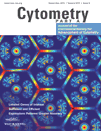
Experiment Overview
| Repository ID: | FR-FCM-ZZY7 | Experiment name: | Dataset 2-Flow Cytometer Sensitivity: A Quadratic Model | MIFlowCyt score: | 50.58% |
| Primary researcher: | Faysal El Khettabi | PI/manager: | Ryan Brinkman | Uploaded by: | Faysal El Khettabi |
| Experiment dates: | 2009-09-15 - 2009-09-15 | Dataset uploaded: | Mar 2012 | Last updated: | Jan 2013 |
| Keywords: | [flow cytometry] [High Throughput] [Doublet] [Mean Fluorescence Intensity (MFI)] [linear and quadratic regressions] [Q (detector efficiency) ] [B (background light level)] [Instrument Sensitivity] [K-means] [Molecules of Equivalent Soluble Fluorochrome (MESF)] [BD CS&T beads] [Kmeans Automatic Clustering] | Manuscripts: | |||
| Organizations: |
BC Cancer Agency, Terry Fox Lab, Vancouver, BC (Canada)
|
||||
| Purpose: | Flow cytometer sensitivity has been well defined in the community and relates to two functions: how well a dimly fluorescent population is resolved from noise or an unstained population, and how well various dim staining populations can be distinguished from each other. In both cases the goal of finding optimal instrument settings to resolve populations based on their fluorescence can be achieved by examining bead particles (microspheres) that contain sub-populations with varying amounts of fluorescence intensity. We used a data provided by University of Rochester Medical Center, Rochester NY. The experiment consisted of running BDtm CS&T beads on an LSRII cytometer at a series of voltages ranging from 200V to 900V at 10V intervals. This dataset was used to explore the effects of various perturbations to cytometer operations to the resulting estimates of Q and B values using the detector assigned to B515 that has the associated MESF-FITC values for the beads. MESF / ABC Information: FITC MESF-5 lot 9545 Peak_1=2562; Peak_2 =22018; Peak_3 =73297; Peak_4 =258460; Peak_5 =756128; MFIs are files with Duke-... MESFs are files with FITC MESF_... | ||||
| Conclusion: | We developed an automated approach to determine a cytometer’s detection efficiency (Q) and background illumination (B) independent of a pre-defined bead set, based on K-means clustering and quadratic regression. We showed that the quadratic formulation for modelling Q offers more physical insight about cytometry sensitivity than its truncated linear version. The developed quadratic regression approach that takes into account intrinsic variance from both the instrument and the bead product is very crucial in this experiment. An adequate illumination correction for the usefulness of the linear regression model is not possible because a number of voltages show a saturation in the bright peak with a CV equal to zero. In the traditional linear model this would incorrectly imply an illumination correction term of 0. As well, using K-means in place of manual gating provided for a fully automated method to calculate the Q and B quantities objectively and in a time-efficient manner. We validated our approach on this flow cytometry sensitivity data experiment through comparison to Q and B values obtained by manual analysis. Our results show a marked improvement in facilitating the use of automated analysis of flow cytometry sensitivity data sets and we conclude that using the quadratic model is more appropriate to help find optimal instrument settings that resolve populations based on their fluorescence. Using the K-means in place of manual gating provides for a fully automated method to calculate Q and B objectively and efficiently. Our approach is freely available through the R/Bioconductor package flowQB. | ||||
| Comments: | Data analysis was conducted using R/BioConductor. We used R’s implementation for K-means clustering to enable the automatic gating and the statistics extraction. The R functions for regression analysis lm was used to fit linear and quadratic regression models. The R function Poly was used to evaluate orthogonal polynomials involved in solving the resulting linear system of equations. We developed a freely available open source R/BioConductor package flowQB to automate the main steps for Q and B calculation, available through CRAN/Bioconductor. It includes a vignette that provides a task-oriented description of its functionality and an executable example that is intended to be used interactively. Thanks to everybody who provided FCS files for this collection! Please email Ryan Brinkman (rbrinkman@bccrc.ca) if you have any questions. | ||||
| Funding: | Not disclosed | ||||
| Quality control: | FCS files have been tested in FlowJo and R flowCore package, which seem to read these without any issues and with a sufficient guarantee compliance with the FCS data file standard. MESF / ABC Information: FITC MESF-5 lot 9545 Peak_1=2562; Peak_2 =22018; Peak_3 =73297; Peak_4 =258460; Peak_5 =756128; | ||||
